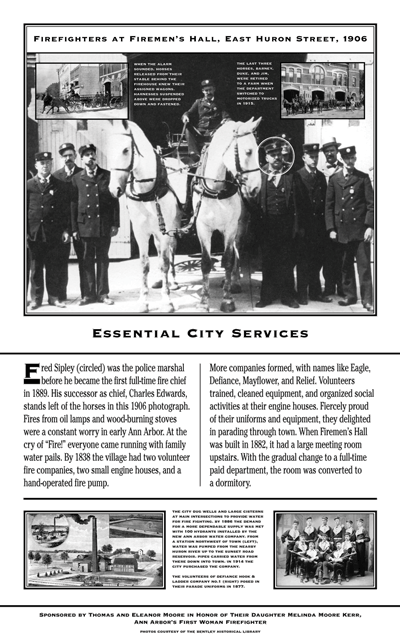SITE 9: WALL DISPLAY : Between Downtown and the Railroad
Sponsored by Zingerman's Community of Businesses
Photos Courtesy of the Bentley Historical Library
|
Click within the image below for a closer look
|
|

SITE 9: WALL DISPLAY : A Changing Neighborhood
Sponsored by the Ann Arbor branch of the National Association for the Advancement of Colored People (NAACP)
Photos Courtesy of the Ann Arbor Observer and Bentley Historical Library
|
Click within the image below for a closer look
|
|

Panel Information: Industry on Detroit Street
In 1869 John G. Miller built this large steam powered planing mill, which specialized in windows, doors, shutters, and gingerbread trim for the growing city. Detroit Street hummed with industrial activity that took advantage of the nearby railroad and lumberyards. Herman Krapf bought the mill in 1878 and ran it until 1905. Like Miller before him, he lived in the house on the left. E. J. Knowlton briefly rented space from Krapf to manufacture his nationally advertised collapsible “Universal Bath.”
The automobile changed the neighborhood. A gas station replaced Schmidt’s carriage factory at Detroit and Kingsley streets. At the Division Street end of the block, an auto dealership opened next to what had been the Ferguson Cart Company. In 1960 the Treasure Mart opened a consignment shop in the old mill. It was the first of many businesses that would become the Kerrytown shopping district.
Panel Information: Between Downtown and the Railroad
Hurd-Holmes's farm implement business was one of many industries between downtown and the railroad. David Henning erected the brick building to your right in 1864 to expand his barrel factory and apple-packing business. It was later Moses Rogers’s farm implement shop, then a creamery, a lumber warehouse, a machine shop,and, as the neighborhood changed, an art gallery,and the first home of the Ecology Center.
On this block in 1835, Ann Arbor’s first Catholic mass was said by Father Patrick O'Kelly in James Horrigan's home. Irish and German Catholics settled nearby and in 1845 built the first St.Thomas church. On the corner to your right in 1899, church member Francis Stofflet built row houses for his married children. On the opposite corner in 1902, Italian immigrant Rocco Disderide moved his house to make way for his new grocery store.
By the 1980s the neighborhood had changed.The row houses became condominiums and the grocery the popular Zingerman’s Delicatessen.
Panel Information: A Changing Neighborhood
In 1956 civic leaders launched a plan, using federal urban renewal funds, to remove “blight” and rebuild this mostly black neighborhood. Many buildings around you were proposed for demolition. Both black and white leaders disagreed among themselves whether the plan would improve the neighborhood or destroy the fabric of the black community. At least 500 residents would have been displaced, 400 of them black. In 1959 City Council narrowly passed the plan, but newly elected Mayor Cecil Creal vetoed it as too disruptive.
Other forces changed the neighborhood. City Council passed a fair housing law in 1963 and a stronger one in 1965. The neighborhood school, Jones Elementary (later Community High), was 75% black in 1965 when it was closed and its students dispersed by bus to other schools in an effort at desegregation. By the 1970s blacks were leaving the neighborhood. The churches moved. In that decade, black and white citizens working together defeated plans for a downtown bypass that would have split the neighborhood.
Panel Information: Ann Arbor’s African American Community
African Americans established a close-knit community in this neighborhood near their churches and the Dunbar Center, a gathering place for all blacks. Bethel African Methodist Episcopal and Second Baptist churches evolved from the small 1853 Union Church nearby at 504 High Street. Nineteenth century blacks were carpenters, masons, blacksmiths, barbers, and draymen, as well as domestics and laborers. They helped build the railroad and the university. In 1890, George Jewett, son of a blacksmith, was UM’s first black football player. He later owned a dry-cleaning business on South State Street. Katherine Crawford, an 1898 UM Medical School graduate, opened a medical practice in her family’s Fuller Street home.
The 1920s building boom created jobs; Ann Arbor’s black population doubled to almost 600. Post World War II prosperity brought that number to 3,200 by 1960. Few, however, were employed in city offices, or on school or university faculties, or held elected positions. Segregated housing practices restricted most black families to this area.
SITE 9: WALL DISPLAY : Ann Arbor’s African American Community
Sponsored by Alpha Kappa Alpha and Delta Sigma Theta Sororities; Alpha Phi Alpha, Kappa Alpha Psi, and Omega Psi Phi Fraternities; Bethel AME Church and Second Baptist Church
Photos courtesy of Rosemarion Blake, the Ann Arbor Community Center, and the Bentley Historical Library
|
Click within the image below for a closer look
|
|

SITE 8: WALL DISPLAY : New City Government, New Issues, and a New City Hall
Sponsored by Margaret Ann Riecker, Judy Dow Rumelhart, and Lynn T. White
Photos courtesy of Judy Dow Rumelhart, Elizabeth Brater, and the Bentley Historical Library
|
Click within the image below for a closer look
|
|

SITE 8: WALL DISPLAY : Essential City Services
Sponsored by Thomas and Eleanor Moore in Honor of Their Daughter Melinda Moore Kerr, Ann Arbor's First Woman Firefighter
Photos Courtesy of the Bentley Historical Library
|
Click within the image below for a closer look
|
|

SITE 5: WALL DISPLAY : Germans on Ashley Street
Sponsored by the owners of Downtown Home and Garden and the Owners of the Schwaben Building
Photos Courtesy of the Bentley Historical Library
|
Click within the image below for a closer look
|
|
